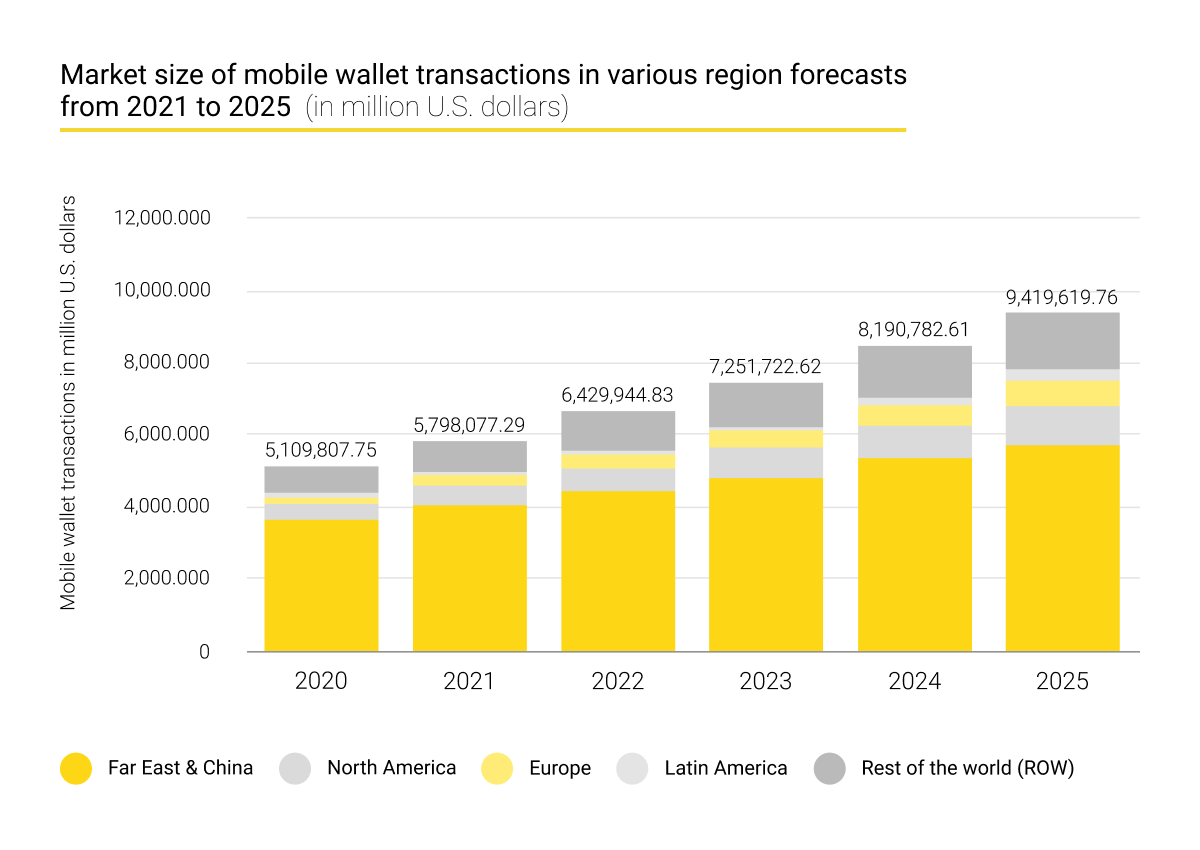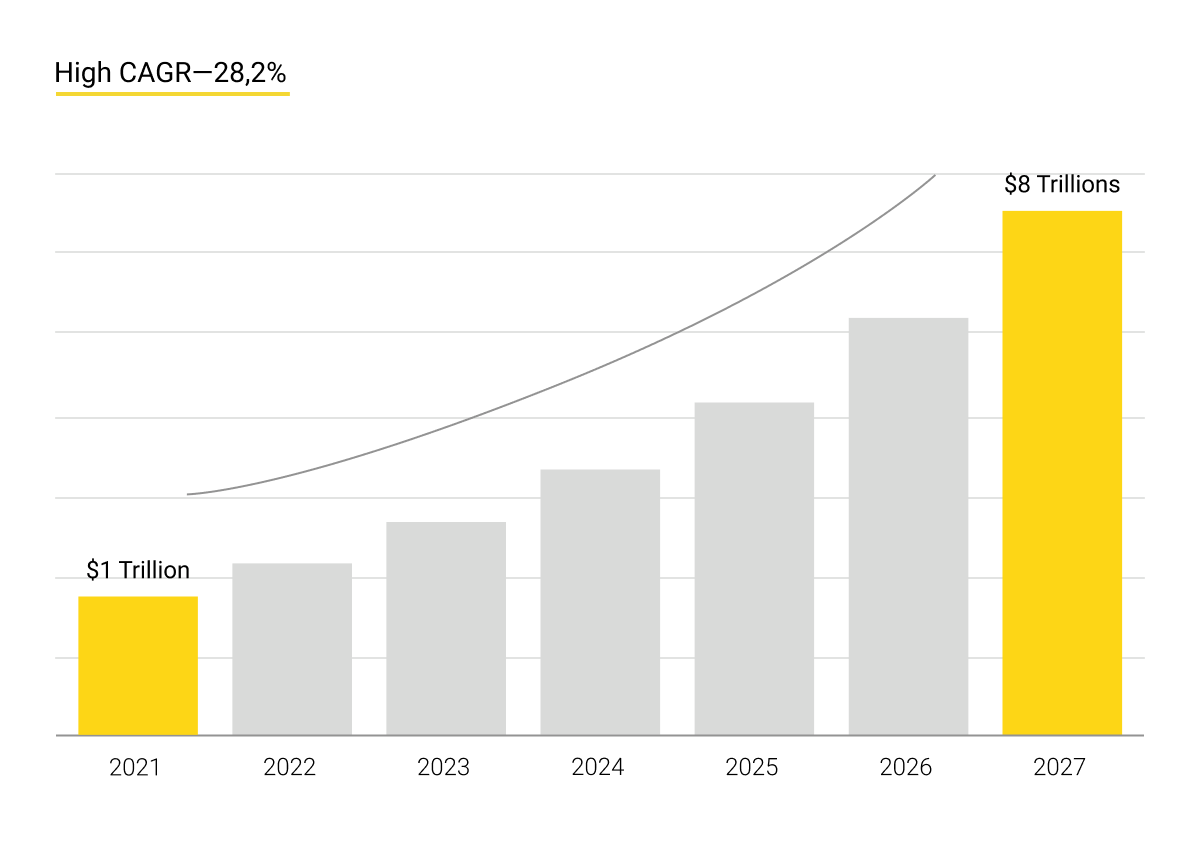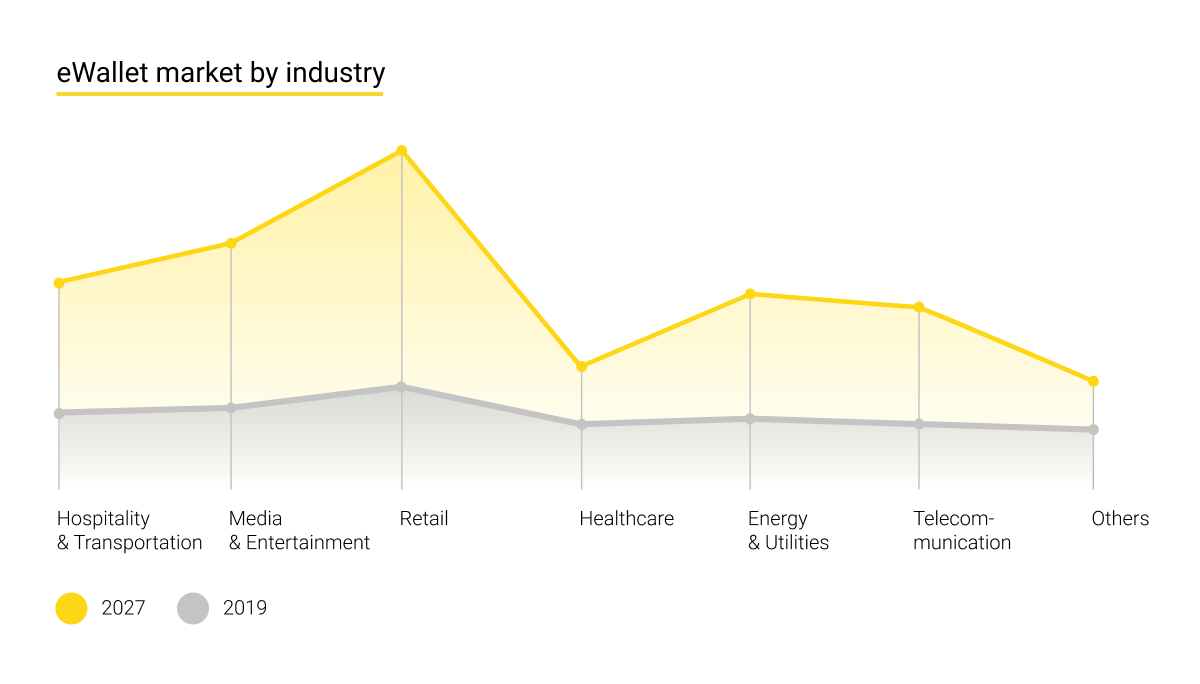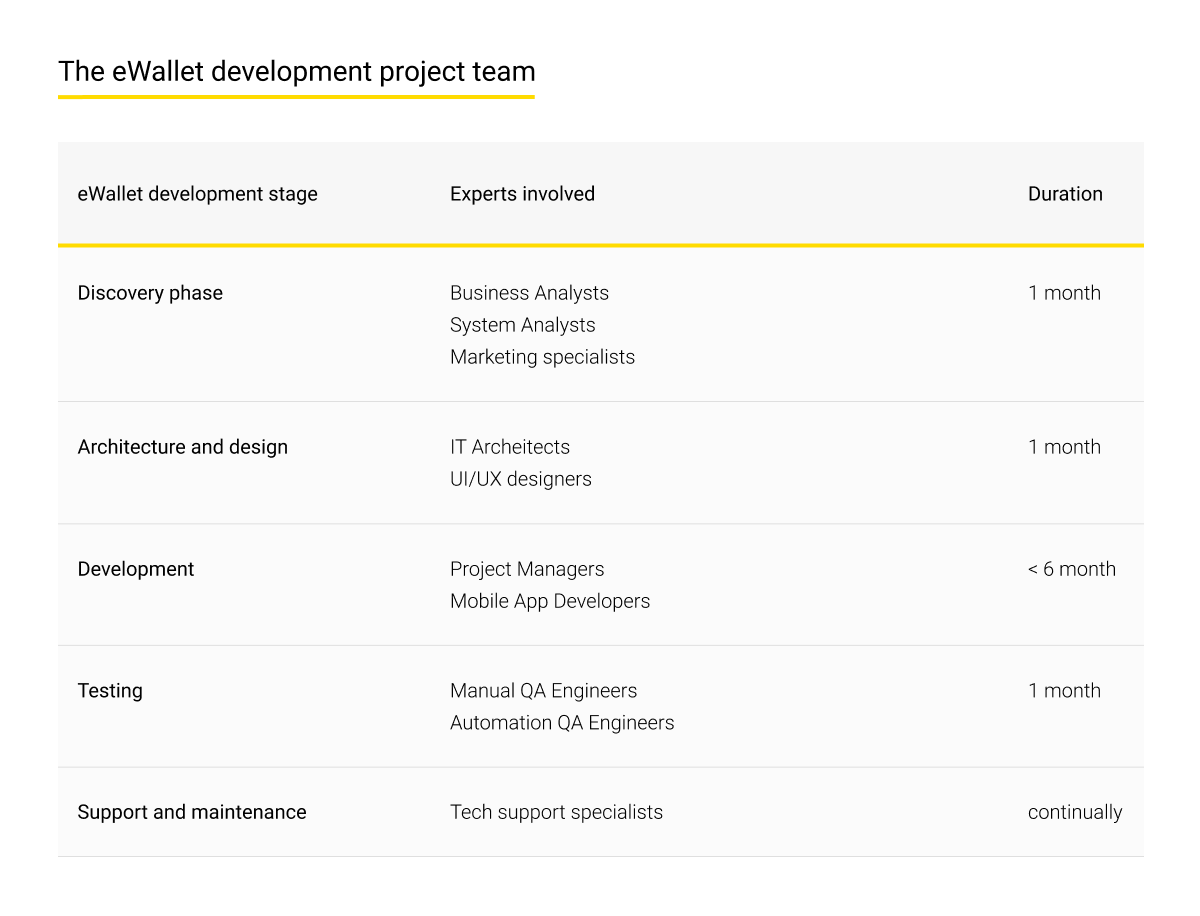In today’s digital world, both individuals and businesses large and small want to pay for goods and services seamlessly and in no time. They can do so by means of digital wallets that provide for the online keeping of their money and transaction details in one app. In North America alone, the number of users of such digital payment solutions is predicted to double by 2025. In view of this, app development is gaining momentum there as well as in the Asian and European markets.

In this piece, we would like to share our insights on how to create an eWallet app that would mark your success in your market niches.
Why is an eWallet mobile app a must?
Digital wallets are growing in popularity as they allow app users to securely link their bank accounts to these payment solutions, perform multicurrency transactions both in-store and online, deposit funds into their wallets, make QR code and NFT payments, and more. Below are just a few compelling facts, demonstrating the increasing worldwide adoption of these solutions:
- by 2024, over a third of shoppers will make in-store purchases using digital wallets;
- in the Asian region, nearly half of all POS payments are already made with eWallets;
- currently, the global eWallet market is annually growing at a CAGR of 28.2%.

Not only are eWallet mobile apps widely employed in all major industries from Finance Services to Logistics and eCommerce, but they are also actively adopted by skyrocketing startups. Digital payments are used in Retail and Banking, for trading, EMI — in a word, everywhere.

Let’s, therefore, take a closer look at eWallet app development costs, milestones, and the essential features that are a must for any stellar solution of this kind.
What are the main types of eWallet apps?
The scope and cost of eWallet app development services are defined by multiple factors, including, but not limited to the solution’s purpose, type, features, platform, design and architecture complexity, and so on.
These apps belong to one of the following types:
- Closed eWallets are specifically-designed custom solutions developed for a particular company. Since they serve as the only transaction channel for its customers, they make it much easier to claim refunds and follow the entire purchase process in one app. When one uses this type of wallet, the money is transferred to the account of a business that owns it, which is the case with Walmart Pay.
- Semi-closed eWallets are employed by business chains and partnering organizations, usually operating in the same region. When using them, clients transfer funds to a single escrow account owned by the digital payment service provider, which is the case with Paytm and Oxygen.
- Open eWallets are the platforms for serving multiple independent organizations in one app. These solutions are linked with partner banking institutions, thus, they are on the receiving end of the transfers. This is a broadly adopted solution type comprising such brands as PayPal, American Express, Amazon Pay, and Google Pay.
- Cryptocurrency eWallets provide for crypto trading and other cryptocurrency operations, using such platforms as Exodus, Coinbase, Electrum, etc., and are notable for their superior security.
Step by step eWallet app development
What does it take to create an outstanding digital payment solution? As a rule, any eWallet mobile app development project includes the following stages:
The Discovery phase
This stage is performed by professional Business Analysts who diligently estimate whether the customer’s initial idea is both economically profitable and technically feasible. BAs examine the customer’s vision of the future app with consideration of its ultimate goal and time and budget limits. They conduct in-depth marketing research, evaluate the solution’s compliance with the industry-specific and regional legal requirements, and analyze the future product’s structure against limitations imposed by current technologies.
Project discovery might take up to one month. As a result, the customer is presented with several ways of solving their problem to choose from, each one with its risks, cost, and timelines. The most significant deliverables at this stage are the product’s well-structured functional and non-functional requirements and a detailed roadmap.
Architecture and design
At this stage IT Architects devise an in-depth app structure consisting of modules and plan for their integration with each other and third-party systems, while skillful designers transform it into visual prototypes. For digital payment solutions, having intuitive and engaging interfaces that allow for making secure and seamless transactions in no time is a must. This stage might take up to one month.
The eWallet development
At this stage the solution architecture is embodied in lines of code shaping the app’s Front-end and Back-end.
The former refers to its visual part that’s visible to users. When working on it, it’s crucial to provide for responsive design ensuring the app’s seamless adoption to users’ preferred devices and screen sizes.
The Back-end is all about the solution’s invisible part allowing for sending queries to a database, receiving responses from the server, and so on. When devising it, it’s essential to ensure that the solution is integrated with a banking network via APIs for flawless transactions.
The entire stage might take up to six months depending on your project’s complexity.
The testing stage
This stage takes place prior to product release. It’s aimed at ensuring that the app functions as planned and specified by the requirements, and all inconsistencies are promptly eliminated.
At this stage, giving particular attention to testing eWallet security is extremely important. Since such solutions hold sensitive client and banking information, all security-related features from locks to biometric passwords and data encryption must be thoroughly tested.
The testing stage might take up to one month.
Support and maintenance stage
This is the process of upgrading and improving the end-product that your eWallet app development company carries out as long as the product is used by the audience. Such post-release cooperation with the development company ensures that the solution remains highly competitive and up-to-date in the context of changing markets and evolving technology.

eWallet app development: key features
Let’s consider the eWallet app features that are a must for an outstanding solution.
Profile creation and user authorization
When creating new accounts, eWallet mobile app users fill in their data and set up a password. They also choose profile settings such as language, location, etc.
Since digital payment solutions store users’ personal details associated with their financial assets, secure multi-factor authentication is found among the required eWallet app features.
Bank account integration and financial operations
Not only is an eWallet linked to a user’s bank account, but it also allows for their credit and debit card integration and card issuance. Therefore, it’s crucial to provide for multiple payment gateways when developing an eWallet.
A feature-rich solution should provide for all kinds of transactions, including online recharge, making payments, currency conversion, cashback support, and more.
GPS tracking
This feature allows the app users to follow their eWallets’ locations in real-time to prevent fraud and quickly find them in case of loss. Some solutions can offer additional benefits to their users based on location.
eReceipts and push notifications
eWallet users want to keep track of every transaction they make. That’s why it’s necessary to provide an in-built eReceipt feature that stores payment details.
Push notifications allow the users to stay updated on important bank information and every transaction that is made via the app.
In-built analytics
Real-time transaction analytics and periodical reports provide the users with valuable insights into their spending and income and help them make informed financial decisions.
NFC and QR payments
In the course of eWallet mobile app development, it’s essential to equip the app with modern payment options such as NFC and QR code payments. This will allow you to increase the solution’s popularity and reach new audiences.
EMI and BNPL payment options
Today, paying for goods and services in installments is much in demand among shoppers. When developing your app, provide them with this option by including payment reminders and implementing the autopay feature.
Support and troubleshooting
By establishing a multi-language live chat with your clients or simply having a chatbot for handling standard requests, you will improve retention rates and gain customer trust.
How to choose a trusted eWallet app development company
When planning for eWallet development, it’s crucial to find a trusted outsourcing company with a proven track record in FinTech solutions. The key criteria for choosing a credible developer include:
- Deep FinTech experience supported by a rich product portfolio and customer reviews. To learn more about your prospective development company, you can check independent opinions and market analytics on reputable ranking platforms such as Clutch, GoodFirms, etc.
- Professionalism and expertise expressed in the complexity of projects that the company has implemented, including the offered technology stacks, platform choice, and adherence to design and development best practices.
- A competitive eWallet app development cost calculated with consideration of the project timelines and budget without compromising its quality.
To sum up
A secure, intuitive, and feature-rich FinTech app is a must in today’s fast-evolving world where users desire to pay bills, buy goods, and get refunds in just a few clicks. Surprisingly, along with a thoroughly devised marketing campaign and incentives such as discounts and money back, a well-designed solution is able to dramatically shape users’ buying behavior.
Choosing a reliable app development company is surely among the key factors that have a substantial impact on your project’s success. If you are interested in world-class eWallet app development services aligned with Agile best practices, consider contacting Andersen’s team. Our top-notch FinTech experts will be delighted to give you a hand with your mobile app development project.
Our expert is ready to help you with complex processes. Schedule a free consultation.

Book a free IT consultation
What happens next?
An expert contacts you after having analyzed your requirements;
If needed, we sign an NDA to ensure the highest privacy level;
We submit a comprehensive project proposal with estimates, timelines, CVs, etc.
Customers who trust us



